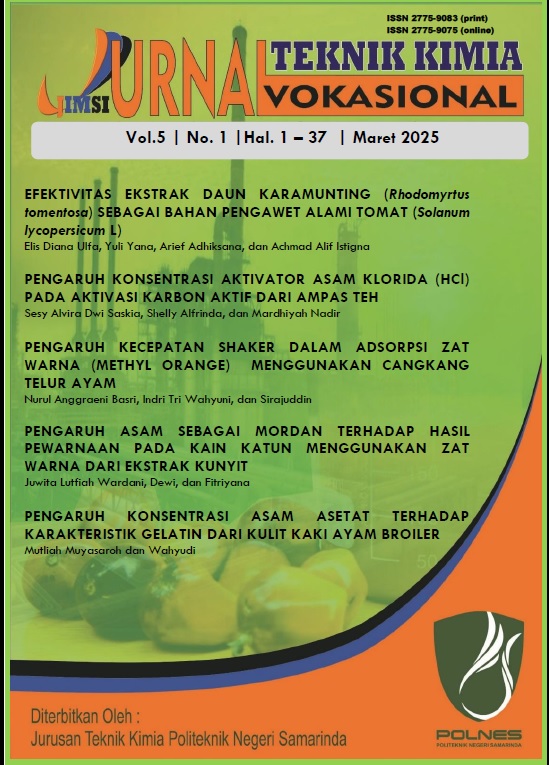Pengaruh Konsentrasi Aktivator Asam Klorida (HCl) pada Aktivasi Karbon Aktif dari Ampas Teh
 Abstract views: 34
,
Abstract views: 34
,
 pdf downloads: 53
pdf downloads: 53
Abstract
Tea dreg is a waste that is often wasted, the utilization of tea waste is still very limited and in a small scope. The field of animal husbandry uses tea as an addition in making compost, besides being used as organic fertilizer, tea dregs can also be used as activated carbon as an adsorbent. In making activated carbon, the content of tea pulp that is taken into account is holocellulose, which is 60.81%. Tea pulp consists of cellulose of 29.42%, and lignin of 36.94%. In making activated carbon, the carbonization process needs to be done. The purpose of this study was to determine the effect of hydrochloric acid (HCl) concentration on the activation of activated carbon from tea dregs on the quality characteristics of activated carbon produced referring to SNI standard No. 06-3730-1995. Tea dregs were carbonized using a furnace at 400 ℃ for 20 minutes with varying concentrations of HCl 0.5 M; 1 M; 1.5 M; 2 M and 2.5 M for 48 hours. The best results were found at 1 M HCl concentration with an iodine absorption value of 896.287 mg/g, moisture content of 8.26%, ash content of 2.91%, volatile matter of 24.33% and fixed carbon of 64.5%.
Copyright (c) 2025 JURNAL TEKNIK KIMIA VOKASIONAL (JIMSI)

This work is licensed under a Creative Commons Attribution-NonCommercial-ShareAlike 4.0 International License.
Copyright Transfer Statement
The copyright of this article is transferred to JIMSI and when the article is accepted for publication. the authors transfer all and all rights into and to paper including but not limited to all copyrights in the Psikostudia. The author represents and warrants that the original is the original and that he/she is the author of this paper unless the material is clearly identified as the original source, with notification of the permission of the copyright owner if necessary. The author states that he has the authority and authority to make and carry out this task.
The author states that:
- This paper has not been published in the same form elsewhere.
- This will not be submitted elsewhere for publication prior to acceptance/rejection by this Journal.
A Copyright permission is obtained for material published elsewhere and who require permission for this reproduction. Furthermore, I / We hereby transfer the unlimited publication rights of the above paper to Jurnal Teknik Kimia Vokasional. Copyright transfer includes exclusive rights to reproduce and distribute articles, including reprints, translations, photographic reproductions, microforms, electronic forms (offline, online), or other similar reproductions.
The author's mark is appropriate for and accepts responsibility for releasing this material on behalf of any and all coauthor. This Agreement shall be signed by at least one author who has obtained the consent of the co-author (s) if applicable. After the submission of this agreement is signed by the author concerned, the amendment of the author or in the order of the author listed shall not be accepted.
Rights / Terms and Conditions Saved
- The author keeps all proprietary rights in every process, procedure, or article creation described in Work.
- The author may reproduce or permit others to reproduce the work or derivative works for the author's personal use or for the use of the company, provided that the source and the Informatika Mulawarman copyright notice are indicated, the copy is not used in any way implying the Jurnal Psikostudia approval of the product or service from any company, and the copy itself is not offered for sale.
- Although authors are permitted to reuse all or part of the Works in other works, this does not include granting third-party requests to reprint, republish, or other types of reuse.
Jurnal Teknik Kimia Vokasional by http://e-journal.polnes.ac.id/index.php/jimsi licensed under a Creative Commons Attribution-ShareAlike 4.0 International License.








